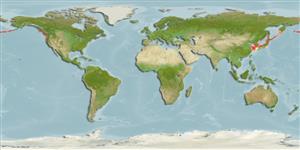Ammodytes personatus Girard, 1856
Pacific sandlance
Add your observation in Fish Watcher
| Native range | All suitable habitat | Point map | Year 2050 |

|
| This map was computer-generated and has not yet been reviewed. |
| Ammodytes personatus AquaMaps Data sources: GBIF OBIS |
Upload your photos and videos
Pictures | Google imageAmmodytes personatus
Picture by Suzuki, T.
Pictures | Google imageAmmodytes personatus
Picture by Suzuki, T.
China country information
Common names:
Miàn tiáo yú, Yù jīn yú, 太平洋玉筋魚
Occurrence: native
Salinity: marine
Abundance: | Ref:
Importance: | Ref:
Aquaculture: | Ref:
Regulations: | Ref:
Uses: no uses
Comments: Occurs in Yellow Sea.
National Checklist:
Country Information: https://www.cia.gov/library/publications/resources/the-world-factbook/geos/ch.html
National Fisheries Authority:
Occurrences: Occurrences Point map
Main Ref: Hong, S.H., I.J. Yeon, Y.J. Im, H.J. Hwang, T.S. Ko and Y.C. Park, 2000
National Database:
Occurrence: native
Salinity: marine
Abundance: | Ref:
Importance: | Ref:
Aquaculture: | Ref:
Regulations: | Ref:
Uses: no uses
Comments: Occurs in Yellow Sea.
National Checklist:
Country Information: https://www.cia.gov/library/publications/resources/the-world-factbook/geos/ch.html
National Fisheries Authority:
Occurrences: Occurrences Point map
Main Ref: Hong, S.H., I.J. Yeon, Y.J. Im, H.J. Hwang, T.S. Ko and Y.C. Park, 2000
National Database:
Common names from other countries
Classification / Names Common names | Synonyms | Catalog of Fishes(genus, species) | ITIS | CoL | WoRMS | Cloffa
Teleostei (teleosts) > Perciformes/Uranoscopoidei (Sand dwellers) > Ammodytidae (Sand lances)
Etymology: Ammodytes: Greek, ammos = sand + Greek, dytes = anyone that likes immersions, diving (Ref. 45335).
More on author: Girard.
Etymology: Ammodytes: Greek, ammos = sand + Greek, dytes = anyone that likes immersions, diving (Ref. 45335).
More on author: Girard.
Environment: milieu / climate zone / depth range / distribution range Ecology
Marine; demersal; oceanodromous (Ref. 51243); depth range 0 - 172 m (Ref. 114018). Temperate; 54°N - 30°N, 118°E - 118°W
Distribution Countries | FAO areas | Ecosystems | Occurrences | Point map | Introductions | Faunafri
Northwest Pacific: inland Sea of Japan to Kyushu, Japan. Northeast Pacific: From southern California to the western Aleutian Islands (Ref. 114018), Alaska (Ref. 11366).
Size / Weight / Age
Maturity: Lm ? range ? - ? cm
Max length : 15.0 cm SL male/unsexed; (Ref. 559); common length : 10.0 cm SL male/unsexed; (Ref. 559); max. published weight: 10.60 g (Ref. 112063); max. reported age: 3.00 years (Ref. 125612)
Max length : 15.0 cm SL male/unsexed; (Ref. 559); common length : 10.0 cm SL male/unsexed; (Ref. 559); max. published weight: 10.60 g (Ref. 112063); max. reported age: 3.00 years (Ref. 125612)
Short description Identification keys | Morphology | Morphometrics
Dorsal spines (total): 0; Dorsal soft rays (total): 55 - 59; Anal spines: 0; Anal soft rays: 28 - 32; Vertebrae: 62 - 67. Characterized by having a horizontal skin fold along its ventral contour, and the absence of pelvic fin and teeth. Lateral plicae 160 to 180. Lower jaw pointed. Lateral line system on head not continuous with that on the body.
Found in sand bottoms and may enter semi-enclosed sea areas (Ref. 11230). Forms large schools. Important food fish in Japan (marketed fresh or dried) and marketed fresh but mainly used for meal and oil manufacture in Europe (Ref. 10384). Common size taken from picture in Ref. 559. Maximum size estimated as 1.5 * common size. Two genetically different lineages were found in Japan Sea/East Sea, perhaps representing two different species (J.K. Kim, oral.comm, FishBoL2012, June 2012).
Life cycle and mating behavior Maturity | Reproduction | Spawning | Eggs | Fecundity | Larvae
Main reference
Upload your references | References | Coordinator | Collaborators
Masuda, H., K. Amaoka, C. Araga, T. Uyeno and T. Yoshino, 1984. The fishes of the Japanese Archipelago. Vol. 1. Tokai University Press, Tokyo, Japan. 437 p. (text). (Ref. 559)
Threat to humans
Harmless
Human uses
Fisheries: highly commercial
FAO(Fisheries: production, species profile; publication : search) | FishSource | Sea Around Us
More information
Population dynamics
Growth parameters
Max. ages / sizes
Length-weight rel.
Length-length rel.
Length-frequencies
Mass conversion
Recruitment
Abundance
Growth parameters
Max. ages / sizes
Length-weight rel.
Length-length rel.
Length-frequencies
Mass conversion
Recruitment
Abundance
Anatomy
Gill area
Brain
Otolith
Gill area
Brain
Otolith
Physiology
Body composition
Nutrients
Oxygen consumption
Swimming type
Swimming speed
Visual pigments
Fish sound
Diseases & Parasites
Toxicity (LC50s)
Body composition
Nutrients
Oxygen consumption
Swimming type
Swimming speed
Visual pigments
Fish sound
Diseases & Parasites
Toxicity (LC50s)
Genetics
Genetics
Heterozygosity
Heritability
Genetics
Heterozygosity
Heritability
Human related
Aquaculture systems
Aquaculture profiles
Strains
Ciguatera cases
Stamps, coins, misc.
Aquaculture systems
Aquaculture profiles
Strains
Ciguatera cases
Stamps, coins, misc.
Tools
E-book | Field guide | Length-frequency wizard | Life-history tool | Point map | Classification Tree
| Catch-MSY |
Special reports
Download XML
Internet sources
Alien/Invasive Species database | Aquatic Commons | BHL | Cloffa | Websites from users | Check FishWatcher | CISTI | Catalog of Fishes(genus, species) | DiscoverLife | ECOTOX | Faunafri | Fishtrace | GenBank(genome, nucleotide) | GloBI | GOBASE | | Google Books | Google Scholar | Google | IGFA World Record | MitoFish | Otolith Atlas of Taiwan Fishes | PubMed | Reef Life Survey | Scirus | SeaLifeBase | Tree of Life | Wikipedia(Go, Search) | World Records Freshwater Fishing | Zoobank | Zoological Record
Estimates based on models
Preferred temperature (Ref. 115969): 11.9 - 23, mean 19.1 (based on 74 cells).
Phylogenetic diversity index (Ref. 82804): PD50 = 0.5156 [Uniqueness, from 0.5 = low to 2.0 = high].
Bayesian length-weight: a=0.00603 (0.00341 - 0.01064), b=3.05 (2.90 - 3.20), in cm Total Length, based on LWR estimates for this species & Genus-body shape (Ref. 93245).
Trophic level (Ref. 69278): 3.1 ±0.1 se; based on size and trophs of closest relatives
Resilience (Ref. 120179): High, minimum population doubling time less than 15 months (K=0.6).
Prior r = 0.79, 95% CL = 0.52 - 1.18, Based on 4 data-limited stock assessments.
Fishing Vulnerability (Ref. 59153): Low vulnerability (14 of 100).
Climate Vulnerability (Ref. 125649): Low vulnerability (17 of 100).




